Why Size is Key in Selecting Running Shoes
Luckily for all runners, we were spared the throes that fashion imposes on other spheres. Never did we need to settle for uncomfortable running shoes only because they matched our outfits. But even though comfort is the primary performance criterion for running footwear, some people still end up with shoes that don’t fit them. Some, following now obsolete fashion trends, prioritize looks over functionality. Others put their faith in their shoes, expecting them to eventually break in and start feeling comfortable. Maybe the offer was too good to pass. All those reasons might seem weighty while you make up your mind, but the result is always the same. People either suffer by wearing these shoes or stop using them whatsoever. In this article, we aim to highlight the importance of prioritizing the comfort of running shoes over all other criteria.
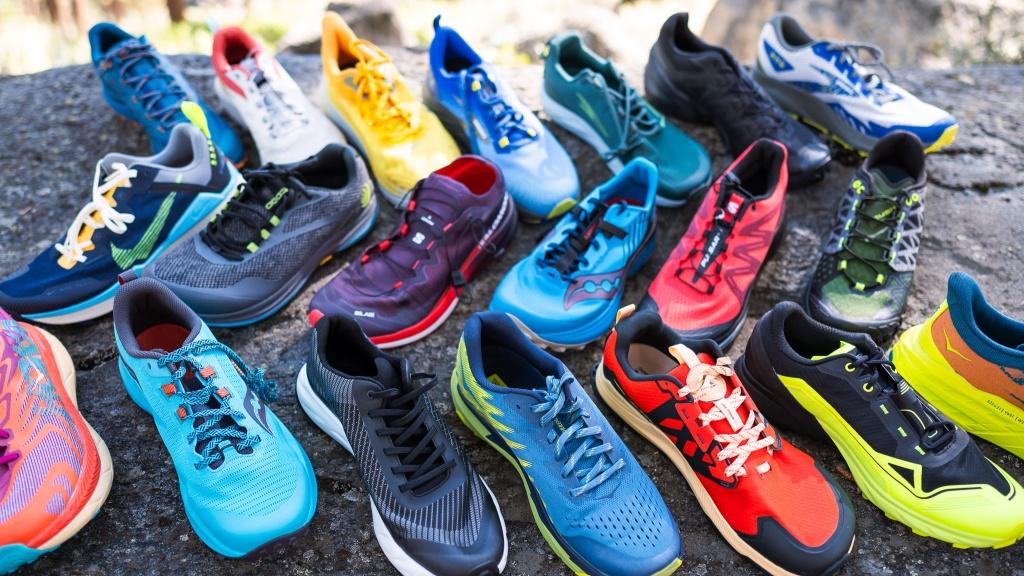
Understanding the Importance of Size in Running Shoes
Every community or fandom has its own scary stories to tell in the dark. And those don’t even need to feature supernatural entities or madmen cut loose. There are things scarier than that because they are more real. Like blackened toenails and blisters. Got goosebumps? Unfortunately, these painful experiences are not fruits of collective imagination, but rather common issues plaguing many runners. Luckily, more often than not, these troubles can be traced back to one simple issue: the fit of our running shoes.
Think about it. Those blisters? They're likely a result of shoes that are too tight or too narrow. That throbbing foot pain? Possibly from footwear that is just too small. And those weary toenails? Often a nasty consequence of not having enough room in the toe box of your shoes. On the flip side, shoes that are too loose, too wide, or have too much room in the heel can cause just as many problems, like foot slippage and consequential falls.
The thing is, these issues aren't just discomforting — they seriously hinder your performance and even lead to long-term injuries. What's more, they can take the joy out of running, turning what should feel like an invigorating and freeing experience into nothing but an ordeal.
But here's the good news: most of these problems can be avoided with the right-fitting running shoes!
Now, you might be thinking, "Great, so I just need to find the right brand or model of shoe, right?" Well, not quite so simple. There's no one-size-fits-all when it comes to running shoes. What works perfectly for one person might be a nightmare for another. That's why understanding how running shoes should fit and feel on your feet is so crucial.
In the next sections, we'll delve deeper into the nitty-gritty of shoe fitting—covering everything from the anatomy of a running shoe to the factors you need to consider when selecting the right size, to how to try running shoes correctly.
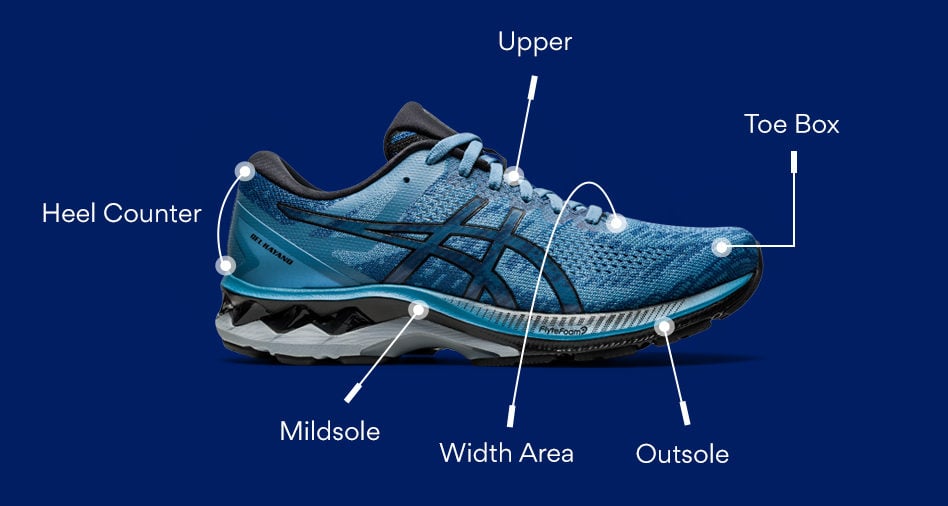
The Anatomy of a Running Shoes
I know it will sound like a platitude coming from the mouth of another running enthusiast, but running shoes are more than just a piece of footwear. They are a complex assembly of various components, working individually and all together to fulfill a specific purpose. Understanding these components and how they interact with your foot can greatly assist you in finding the perfect fit. Let's break down the anatomy of a running shoe. Not all components are directly related to sizing, but it might be helpful to know them anyway.
- Upper: This is the top part of the shoe that wraps around your foot, holding it in place. It's typically made of lightweight, breathable materials to keep your foot cool and dry. The upper should be snug but not tight, providing enough room for your foot to breathe but not so much that it slides around.
- Toe Box: Located at the front of the upper, the toe box delineates space for your toes. It should be roomy enough to allow your toes to wiggle freely, but not so big that your foot slides forward when running downhill. Leave about an inch or half an inch between the tip of your big toe (or whichever toe is the longest) and the front of your shoes.
- Heel Counter: This is a stiff cup incorporated into the rear of the upper to secure your heel. It helps control the side-to-side motion of your foot and adds stability to the shoe. A well-fitted heel counter prevents your foot from slipping out of the shoe.
- Midsole: The midsole is the cushioned layer between the upper and the outsole. It absorbs shock and disperses it across the foot, reducing the impact on your joints when you run. The midsole can be made from various materials, each offering different levels of cushioning and support. Your choice of midsole can significantly affect the comfort and performance of your running shoe.
- Outsole: The outsole, or the bottom of the shoe, is the part that comes in contact with whichever surface you are running on. As such, it needs to be highly durable to protect your foot from sharp objects and slip-resistant to help you keep your balance on slippery surfaces.
- Insole: This is the removable layer inside the shoe that provides additional cushioning and support. As a rule, professional and long-time runners replace standard insoles with custom-made ones to ensure an even more personalized fit or address specific foot issues.
- Lacing System: The lacing system allows you to adjust the fit of the shoe. They can make shoes that feel a bit too spacious comfortably snug, or vice versa.
Each of these parts plays a crucial role in how a running shoe fits and performs. When trying on running shoes, pay attention to each of these elements and how they interact with your foot.
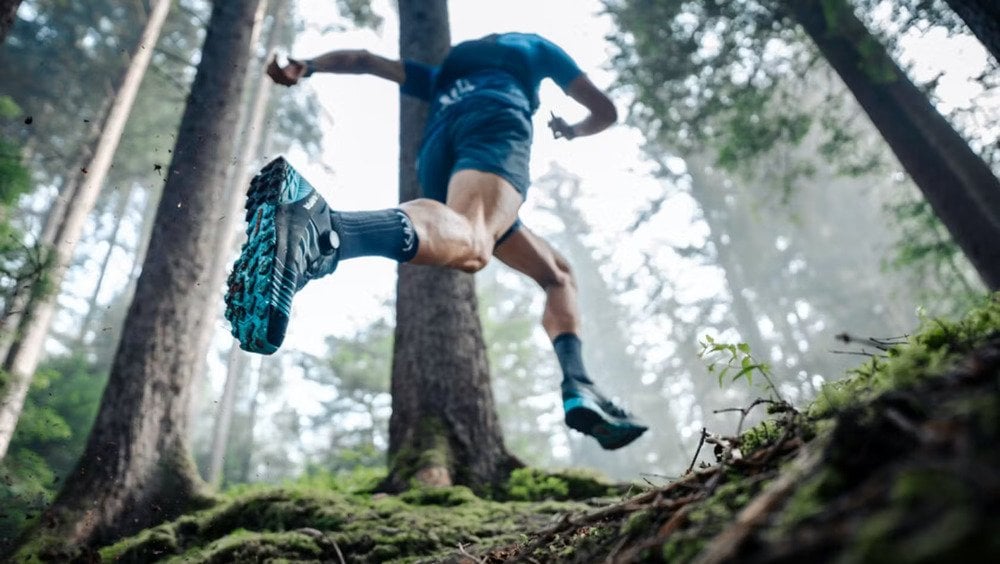
Factors to Consider When Selecting the Right Size
So, you're ready to find that perfect pair of running shoes. But where do you start? Picking the right size isn't always as simple as knowing your usual shoe size. You’ll need to consider several other factors to find a shoe that fits like a glove. Here they are:
- Foot Shape: Feet are like snowflakes — no two are exactly alike. Some of us have narrow feet, others wide, and most are somewhere in between. Knowing your foot shape can be a useful pointer on your way toward the right shoe width. And don't forget about your arches! High, low or neutral arches all require different levels of support.
- Sock Thickness: The socks you plan to wear while running will affect how your shoes fit. Thick, padded socks might necessitate a slightly larger size, while thin, lightweight socks may call for a snugger fit. Having a separate pair for either of the scenarios is the best solution.
- Running Terrain: The running terrain has a significant impact on your running performance and, consequently, will determine your choice of shoes. If you're tackling trails or uneven surfaces, you might prefer a slightly larger shoe to accommodate foot swelling and give some space to account for the elevation difference. On the other hand, if you're sticking to flat, even surfaces like a track or treadmill, a more precise fit of road running shoes might be more suitable, as it allows for more control.
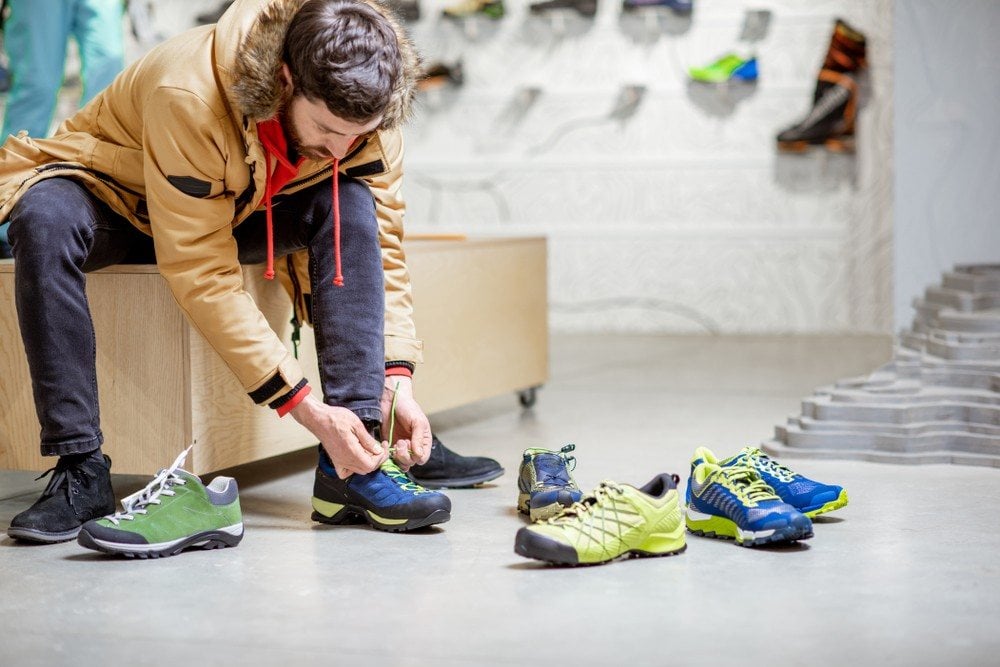
How to Try on Running Shoes Correctly
Slipping your foot in a shoe and seeing if it fits might sound like an appealing fitting session, but things are a bit more. Let's walk through the steps of trying on running shoes correctly to ensure you get the best fit possible:
- Wear Appropriate Socks: We’ve already covered that point, but one more time wouldn’t hurt. Always wear the type of socks you plan to run in when trying on running shoes. This will give you the most accurate sense of how the shoes will feel during a run.
- Choose the Right Time of Day: Believe it or not, the time of day matters when trying on shoes. Don’t set off for a new pair of running shoes first thing in the morning. Our feet tend to swell throughout the day, so they're usually at their largest in the afternoon or evening. To account for this natural swelling, try to schedule your shoe shopping later in the day. This will ensure that your shoes won't feel too tight after you’ve run a while.
- Proper Lacing: When you're trying on the shoe, make sure to lace it up just as you would when going for a run. The lacing system plays a crucial role in securing your foot and providing a decent level of support. Don't leave it too loose, or you won't get an accurate feel for the shoe's fit.
- Take Them for a Test Drive: Don't just stand there — walk around in the shoes. You will get different sensations from wearing them while being active or standing idly. Better yet, if the store allows, take a short jog. You want to mimic the actual conditions you'll be using them under as closely as possible. Pay attention to any discomfort, rubbing, or sliding. Remember: what might feel like a minor annoyance in the store could turn into a major pain in the long run.
- Listen to Your Feet: Above all, listen to what your feet are telling you. Without words, they speak and sometimes even scream. No matter how highly rated or recommended a shoe is, if it doesn't feel comfortable to you, it's not the right fit. Trust your sensations.
- Bigger is Better: Lastly, if you find yourself torn between two sizes, it's generally better to size up. A little extra room is usually preferable to a tight fit: you can wear thicker socks, or lace them more tightly, but you can’t make your foot smaller.
Remember, finding the right running shoe size isn't an exact science. It's about paying attention to the factors we’ve outlined, listening to your body, and of course, a bit of trial and error. But it all pays off when you finally find that perfect fit.
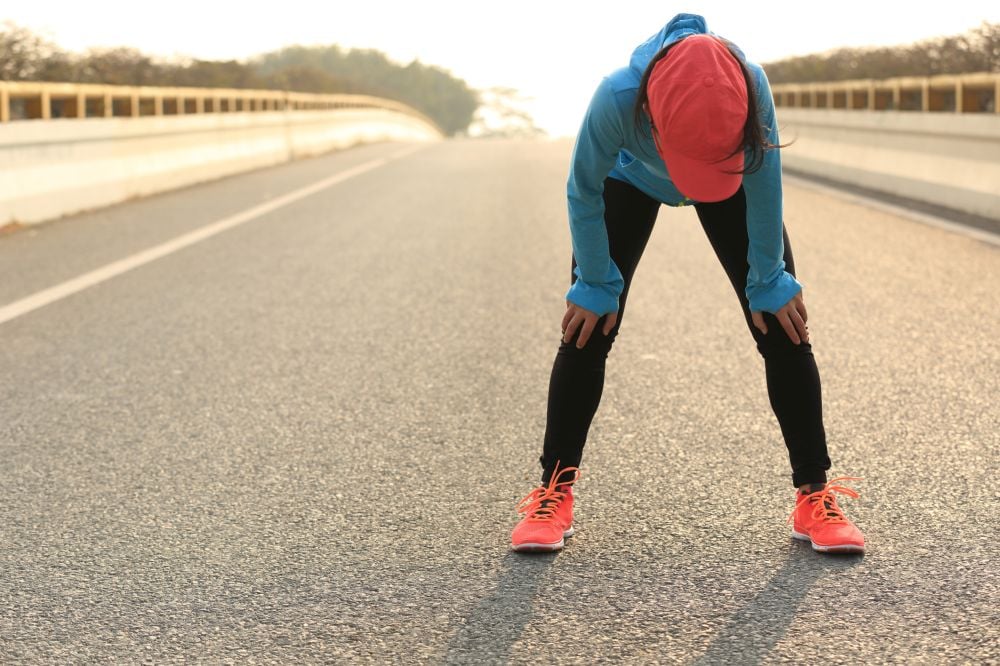
Common Myths About Running Shoe Sizing
The road to a perfect pair of running shoes isn’t without its difficulties. There are several myths about shoe sizing that can lead you astray at any moment, putting the whole operation at risk. Here are some statements that don’t hold water when put to the test:
- Shoes Come in Standard Sizes: This is perhaps one of the most widespread shoe sizing myths. The truth is, there is no such thing as a standard shoe size. Some brands aren’t consistent with the sizing of their own shoe models, not to mention the lack of general sizing standards in the industry. Your shoe size is not a fixed number but rather a starting point in your search for a well-fitting shoe.
- Shoe Will Stretch with Time: Some materials will give a bit, and the shoe will break in after a while, but the scope of this break-in is pretty limited. Don't count on significant stretching. If your union isn’t comfortable from the start, the chances of it improving over time are very low.
- Take Half-Size Bigger Than Usual: If you were thinking about ordering a pair of running shoes online just going half-a-size bigger than usual, don’t. While it's crucial to have enough room in your running shoes to accommodate a variety of things, this doesn't mean you should automatically go a half-size up. A brand might have a size chart different from what you expect. To avoid wasting both time and money, drop by your local running footwear store or at least consult a specialist.
- A Wide Foot Simply Means a Larger Size: Having a wide foot does not automatically mean you need to opt for a bigger size. Bigger shoes won’t only be wider, but also longer. But you don’t need to sacrifice comfort to simply gain the ability to squeeze your foot in. There are shoes designed specifically for wider feet. They’ll preserve the comfortable length while simply being wider.
Conclusion
We hope the list of reasons to prioritize comfort when selecting running footwear was at least somewhat persuasive. We can enjoy wearing oversize clothing, but, for better or worse, this trend doesn’t apply to footwear. Only shoes that fit will bring true joy to their wearer. Only in them can we achieve our best results and remain motivated to keep running. Shoes can either make you run or break it. It is well within your power to make sure they never do the latter.
Check out our other articles on running footwear:
- The Best Insoles For Running Shoes
- How Different Types of Athletic Shoes Can Help Prevent Injuries
- Why Wearing Proper Athletic Footwear Is Important
- Choosing the Right Running Shoe for Foot Types & Running Styles
FAQs
What is the importance of choosing the right size in running shoes?
Choosing the right size in running shoes is crucial for comfort, injury prevention and optimal performance. Ill-fitting shoes often cause discomfort, blisters and even lead to long-term foot problems.
Should running shoes be a size bigger than my regular shoes?
Whereas your running shoes can be half a size to a full size bigger than your regular shoes, it's not always the case. Your feet do need some place to expand during running due to increased blood flow, but a lot depends on the footwear design. If the brand has a peculiar size chart, it is much better to try on such shoes in person.
What are common mistakes people make when selecting running shoes?
The most common mistake that people make is buying shoes that are too small hoping they will break in with time. Expecting shoe sizes to be consistent across different brands is another common mistake. It's also a common thing not to account for foot swelling during long runs.
EXPLORE POPULAR ARTICLES
-
How to Break In Running Shoes [Expert Guide]
Jun 20th 2024It's rare when a couple of short walks around the block is enough for a runner to break in a new pai
-
goodr sunglasses: Choosing the Perfect Pair
May 24th 2024Runners and outdoor fitness enthusiasts know how important good sports sunglasses are. They prote
-
Selecting the Best Running Shoes for Heavy Runners
Mar 28th 2024Running ranks on the list of activities anyone can enroll in. You don’t need any specific equipme


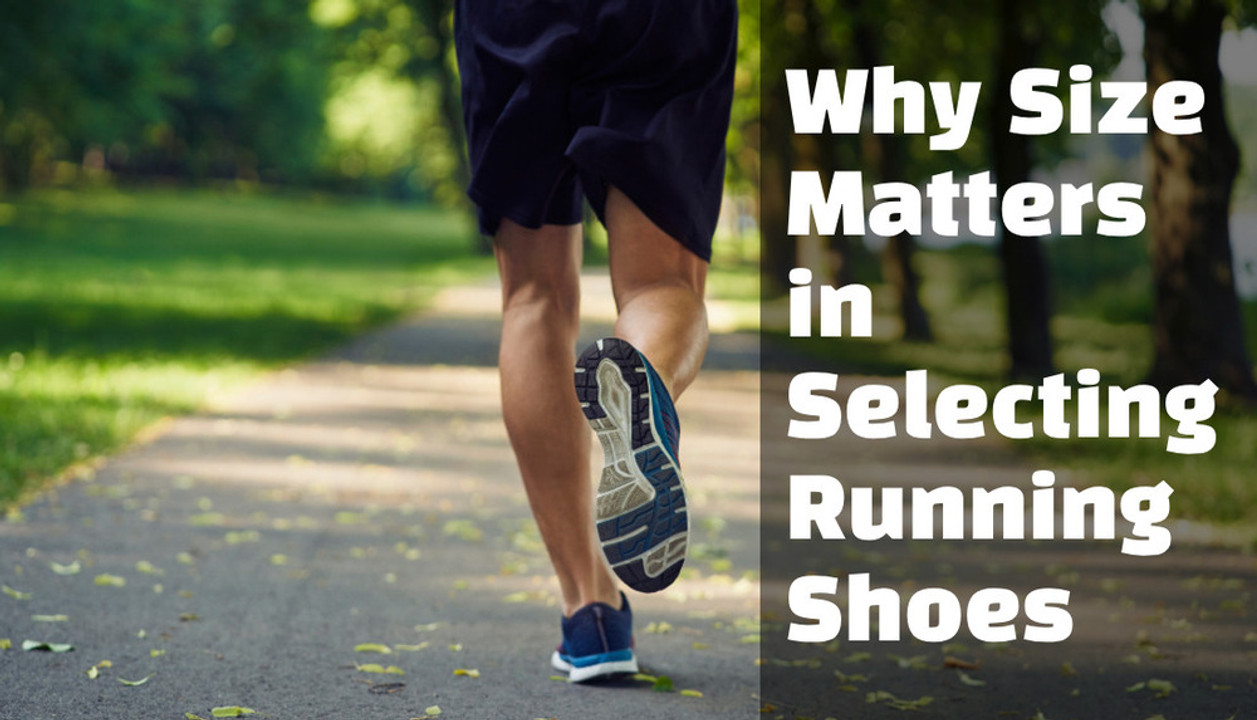
![How to Break In Running Shoes [Expert Guide] How to Break In Running Shoes [Expert Guide]](https://cdn11.bigcommerce.com/s-eeul26hjka/images/stencil/160w/uploaded_images/how-to-break-in-running-shoes.jpg?t=1718884434)

